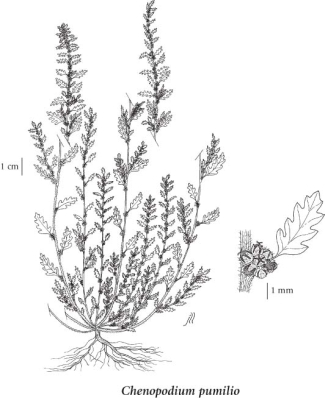Dysphania pumilio (R. Br.) Mosyakin & Clemants
Australian goosefoot (clammy goosefoot)
Amaranthaceae (Amaranth family)
(Previously in Chenopodiaceae)
Introduction to Vascular Plants
Australian goosefoot (clammy goosefoot)
Amaranthaceae (Amaranth family)
(Previously in Chenopodiaceae)
Introduction to Vascular Plants
Species Information
General:
Annual herb from a taproot; stems prostrate to ascending, solitary, freely branched from the base, 20-40 cm tall/long.
Leaves:
Stem leaves alternate, fleshy, stalked, oblong or lanceolate, 1-3 cm long, 2-4 coarse teeth on each side, with numerous yellow glands below, aromatic, reduced upwards.
Flowers:
Inflorescence of numerous axillary clusters, greenish.
Fruits:
Thin, whitish, membranous envelopes; seeds lens-shaped with a raised margin, laterally flattened, 0.5-0.6 mm wide, erect.
Illustration

If more than one illustration is available for a species (e.g., separate illustrations were provided for two subspecies) then links to the separate images will be provided below. Note that individual subspecies or varietal illustrations are not always available.
Illustration Source: The Illustrated Flora of British Columbia
Habitat and Range
Mesic to dry beaches, lake shorelines and disturbed areas in the montane zone; rare in SE BC, known only from the Christina Lake area; introduced from Australia.Status Information
Synonyms
Synonyms and Alternate Names:
Chenopodium carinatum auct. non R. Br. [misapplied]
Chenopodium pumilio R. Br.
Teloxys pumilio (R. Br.) W.A. Weber